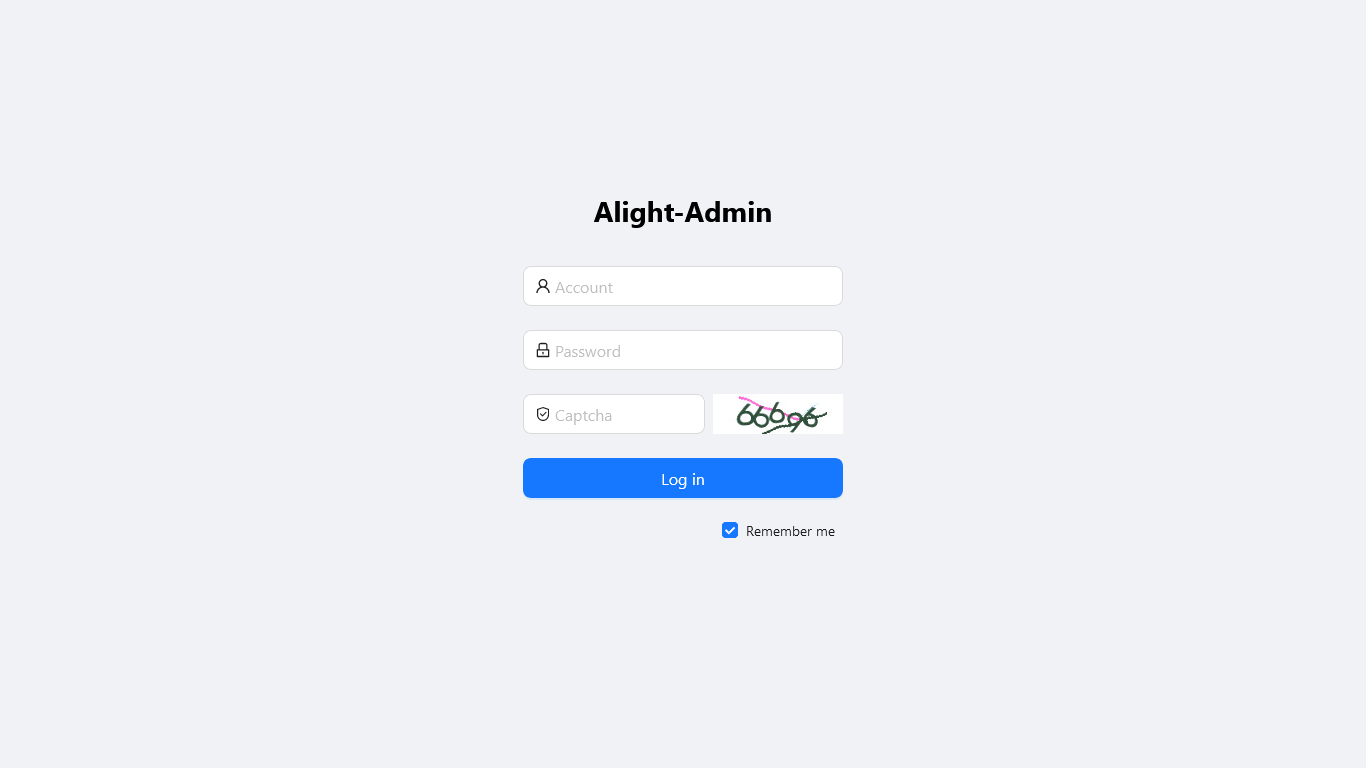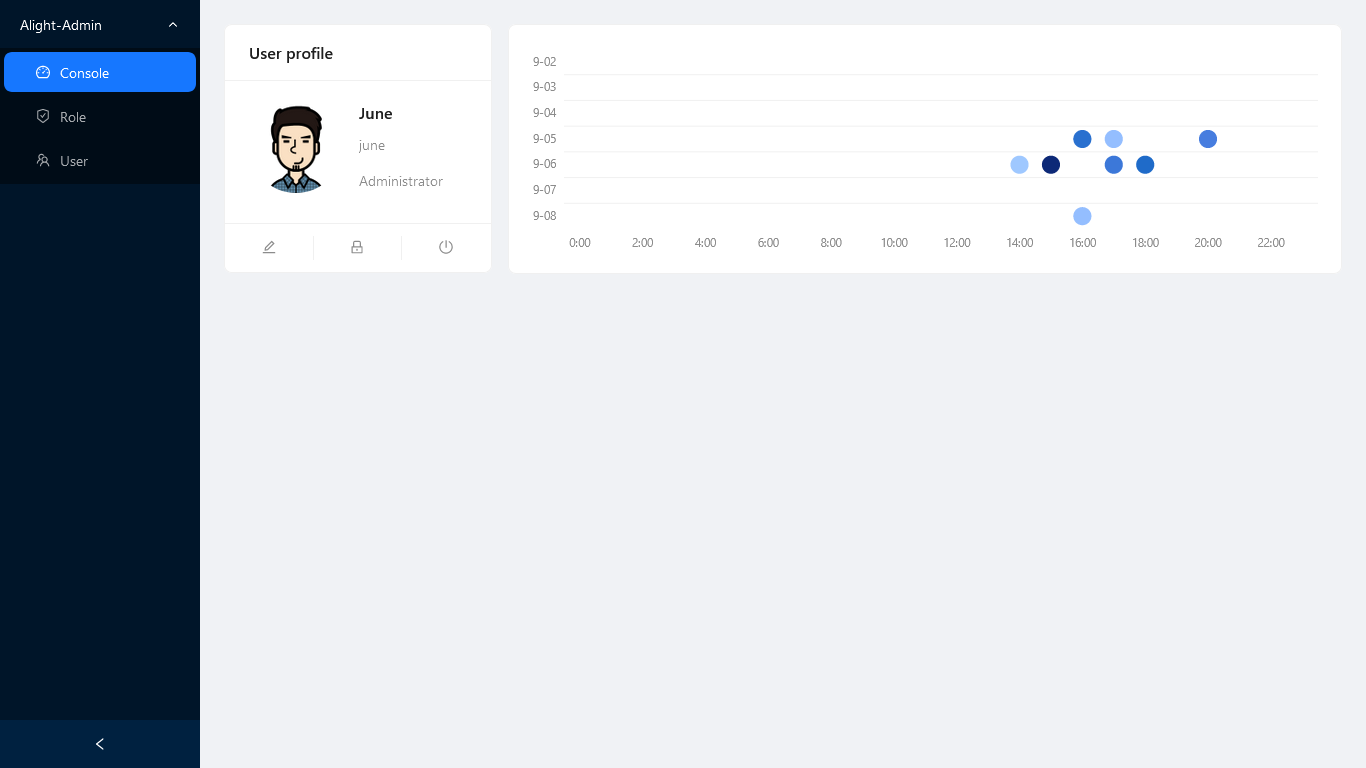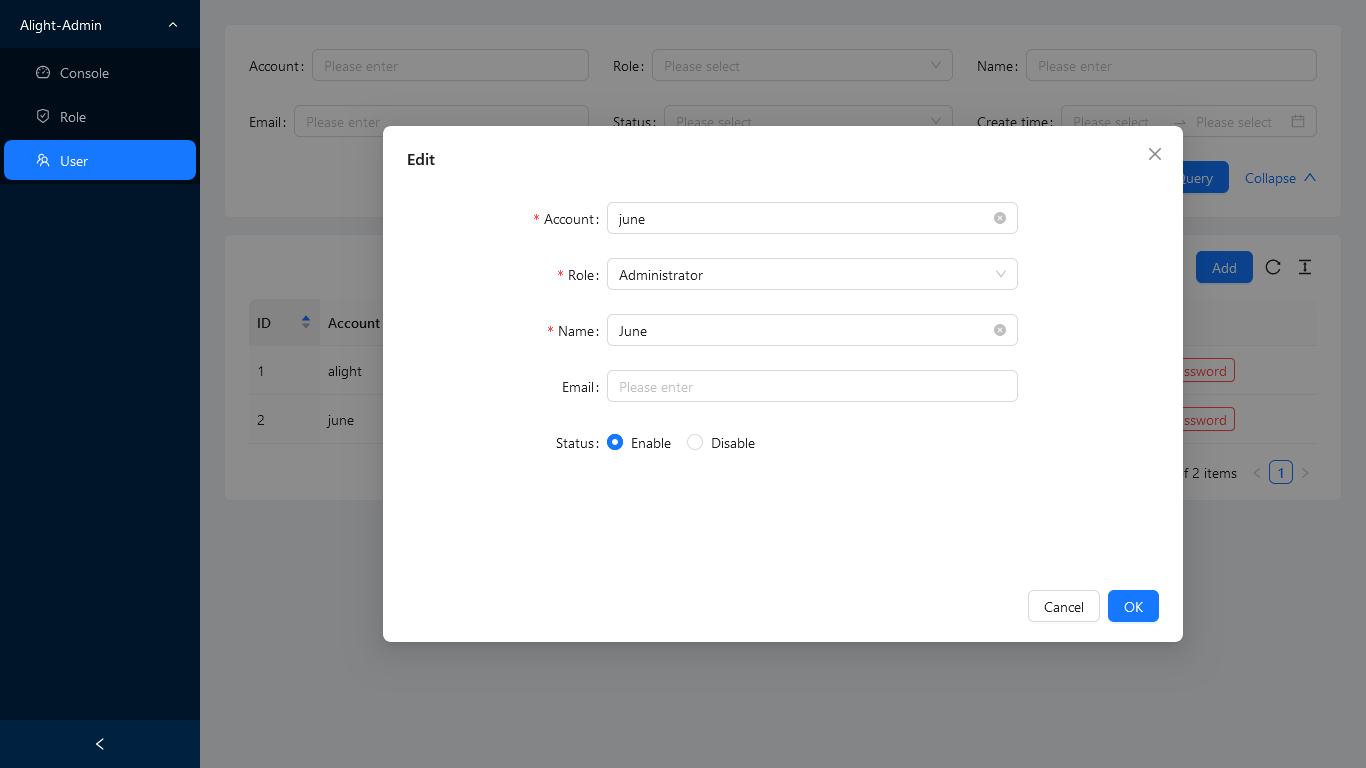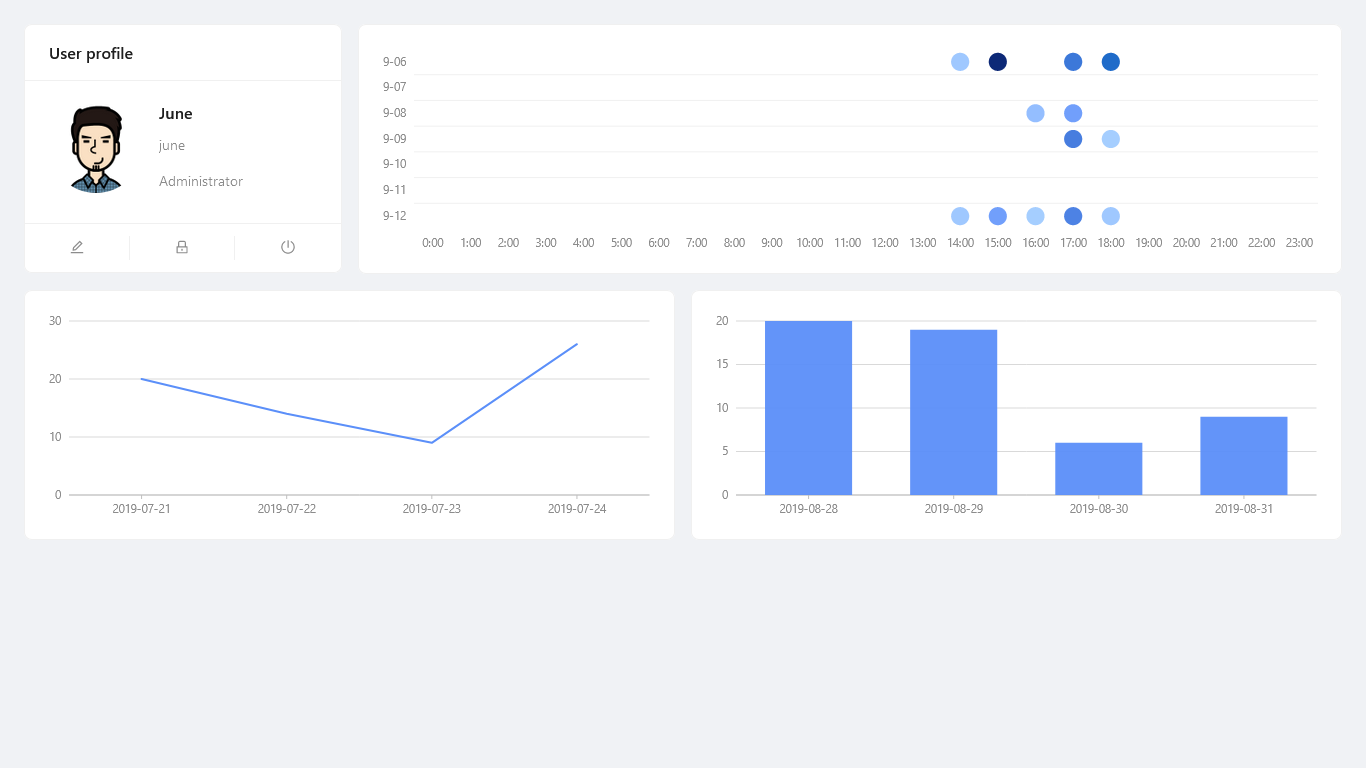juneszh / alight-admin
Alight Admin is a quick admin panel extension based on the Alight framework.
Installs: 305
Dependents: 0
Suggesters: 0
Security: 0
Stars: 8
Watchers: 1
Forks: 0
Open Issues: 0
pkg:composer/juneszh/alight-admin
Requires
- php: >=7.4
- gregwar/captcha: ^1.2
- juneszh/alight: *
- symfony/var-exporter: >=5.4
README
Alight-Admin is a quick admin panel extension based on the Alight framework.
Features
- No front-end coding required. Built-in Ant Design UI (React) components and driven by PHP interface.
- Quickly build and easily configure CRUD pages with Table/From render.
- Includes authorization, permissions and user management.
- Customizable Charts displayed in the console by PHP, such as Line, Column, Pie, etc.
Alight Family
| Project | Description |
|---|---|
| Alight | Basic framework built-in routing, database, caching, etc. |
| Alight-Admin | A full admin panel extension based on Alight. No front-end coding required. |
| Alight-Project | A template for beginner to easily create web applications by Alight/Alight-Admin. |
Requirements
PHP 7.4+
Usage
Alight-Admin can be quickly built using Alight-Project.
Creating Project
$ composer create-project juneszh/alight-project {PROJECT_DIRECTORY}
Initialize Admin
The following commands will build the runtime environment required by Alight-Admin, such as installing composer package, inserting configuration options, creating database tables, and downloading front-end resources. Please make sure the database has been configured.
$ cd {PROJECT_DIRECTORY}
$ composer require juneszh/alight-admin
$ composer run admin-install
$ composer run admin-download
Try the CRUD
Suppose we already have a database table: admin_user
| Name | Datatype | Default |
|---|---|---|
| id | SMALLINT | AUTO_INCREMENT |
| account | VARCHAR | |
| password | VARCHAR | |
| name | VARCHAR | |
| VARCHAR | ||
| role_id | TINYINT | 0 |
| status | TINYINT | 1 |
| auth_key | VARCHAR | |
| create_time | TIMESTAMP | CURRENT_TIMESTAMP |
Now, create a php table function under controller. For example:
File: app/controller/admin/Test.php
<?php namespace ctr\admin; use Alight\Admin\Auth; use Alight\Admin\Form; use Alight\Admin\Table; class Test { public static function userTable() { // Check the role_id from logged in user Auth::checkRole([1]); // Here '1' means only administrators have access // Create the table columns and search bar Table::column('id')->sort('ascend'); Table::column('account')->search()->sort(); Table::column('role_id')->search('select')->enum([1 => 'Administrator', 2 => 'Editor']); Table::column('name')->search(); Table::column('email')->search(); Table::column('status')->search('select')->enum([1 => 'Enable', 2 => 'Disable']); Table::column('create_time')->search('dateRange'); // Create the buttons Table::button('add')->toolbar(); // Here 'toolbar()' means this button will be placed on toolbar Table::button('edit'); Table::button('password')->danger(); // Bind the database table 'admin_user' and render table page Table::render('admin_user'); } }
Then, we will get the table page as:
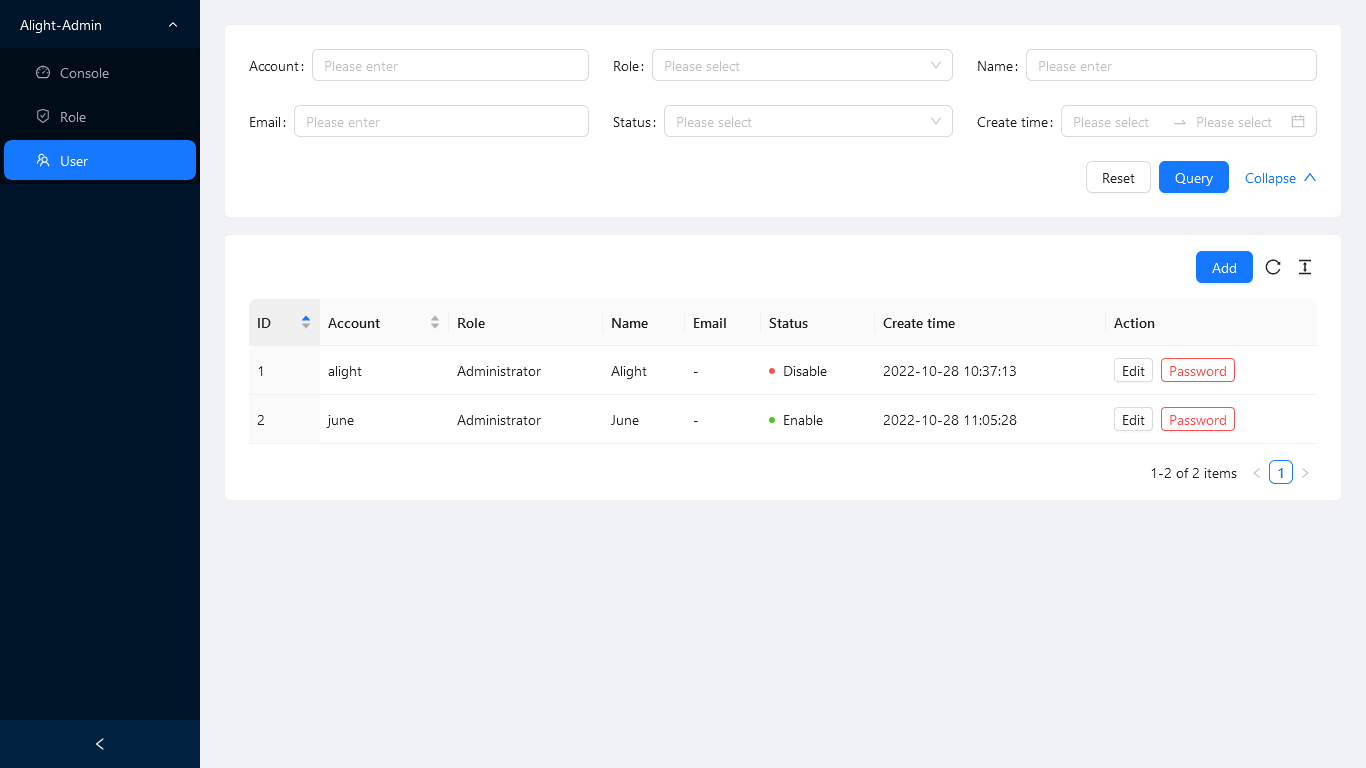 (In order to make the code more compact, some settings are omitted, such as: column title, status point, etc.)
(In order to make the code more compact, some settings are omitted, such as: column title, status point, etc.)
Next, we go ahead and create a form function:
public static function userForm() { // Ditto, Check the user access Auth::checkRole([1]); // Create the form fields Form::create('add'); // This form will bind the 'add' button Form::field('account')->required(); Form::field('role_id')->type('select')->enum([1 => 'Administrator', 2 => 'Editor'])->required()->default(1); Form::field('name')->required(); Form::field('email'); Form::field('password')->type('password')->required(); Form::field('confirm_password')->database(false)->type('password')->required()->confirm('password'); // Create another form Form::create('edit')->copy('add'); // This form will bind the 'edit' button and copy fields from 'add' Form::field('password')->delete(); Form::field('confirm_password')->delete(); Form::field('status')->type('radio')->enum([1 => 'Enable', 2 => 'Disable']); // Create last form for 'password' button Form::create('password')->copy('add', ['password', 'confirm_password']); // Bind the database table 'admin_user' and render form page Form::render('admin_user'); }
Then, we will get the form page as:
The last step, configure routing and side menu:
File: app/config/route/admin.php
Route::get('test/user/table', [ctr\admin\Test::class, 'userTable'])->auth(); Route::any('test/user/form', [ctr\admin\Test::class, 'userForm'])->auth();
File: app/config/admin/menu.php
Menu::item('Test'); Menu::subItem('User')->url('test/user/table');
Finally, the database table user_admin has completed CRUD creation. See API LIST for more information.
Try the Console Charts
Create charts with built-in data.
File: app/config/admin/console.php
// Here using Line charts, we support 30+ charts with AntDesign Charts // More details please refer to : https://ant-design-charts.antgroup.com/en/examples Console::chart('Line')->config([ 'xField' => 'date', 'yField' => 'value', 'height' => 200, 'data' => [ ['date' => '2019-07-21', 'value' => 20], ['date' => '2019-07-22', 'value' => 14], ['date' => '2019-07-23', 'value' => 9], ['date' => '2019-07-24', 'value' => 26] ] ])->grid(['span' => 12]); // Means half the width of the grid. full of 24
Create charts with api data.
File: app/config/admin/console.php
Console::chart('Column')->config([ 'xField' => 'date', 'yField' => 'value', 'height' => 200 ])->grid(['span' => 12])->api('test/column'); // Define the path to the API
File: app/controller/admin/Test.php
public static function columnData() { // Check the user access Auth::checkRole([1]); $data => [ ['date' => '2019-08-28', 'value' => 20], ['date' => '2019-08-29', 'value' => 19], ['date' => '2019-08-30', 'value' => 6], ['date' => '2019-08-31', 'value' => 9] ]; // Response using the built-in json format api Alight\Response::api(0, null, ['data' => $data]); }
File: app/config/route/admin.php
Route::get('test/column', [ctr\admin\Test::class, 'columnData'])->auth();
Finally, we will get the console page as:
API
- Alight\Admin\Table
- ::button()
- ->action()
- ->batch()
- ->color()
- ->column()
- ->expand()
- ->if()
- ->param()
- ->role()
- ->title()
- ->toolbar()
- ->url()
- ->variant()
- ::column()
- ->align()
- ->copyable()
- ->database()
- ->ellipsis()
- ->enum()
- ->fixed()
- ->hide()
- ->html()
- ->role()
- ->search()
- ->sort()
- ->title()
- ->tooltip()
- ->type()
- ->width()
- ::expand()
- ->align()
- ->copyable()
- ->enum()
- ->fixed()
- ->hide()
- ->html()
- ->role()
- ->sort()
- ->title()
- ->tooltip()
- ->width()
- ::statistic()
- ->title()
- ->value()
- ::summary()
- ->avg()
- ->precision()
- ::render()
- ::button()
- Alight\Admin\Form
- ::create()
- ->copy()
- ::field()
- ->confirm()
- ->database()
- ->default()
- ->delete()
- ->disabled()
- ->enum()
- ->grid()
- ->hide()
- ->placeholder()
- ->raw()
- ->readonly()
- ->required()
- ->role()
- ->rules()
- ->title()
- ->tooltip()
- ->type()
- ::render()
- ::create()
- Alight\Admin\Console
- ::chart()
- ->api()
- ->config()
- ->grid()
- ->role()
- ::build()
- ::chart()
- Alight\Admin\Menu
- ::item()
- ->action()
- ->role()
- ->url()
- ::subItem()
- ->action()
- ->role()
- ->url()
- ::build()
- ::item()
Credits
- Composer requires
- UI components

